Thumpalumpacus
Lieutenant Colonel
The USN YE/ZB system was pilot operable, but to be fair it was not fully implemented until 1942 and even then pilots were often unfamiliar with it.
Not only that, it required more altitude, and wasn't always reliably receivable even then, at least in SoPac.



